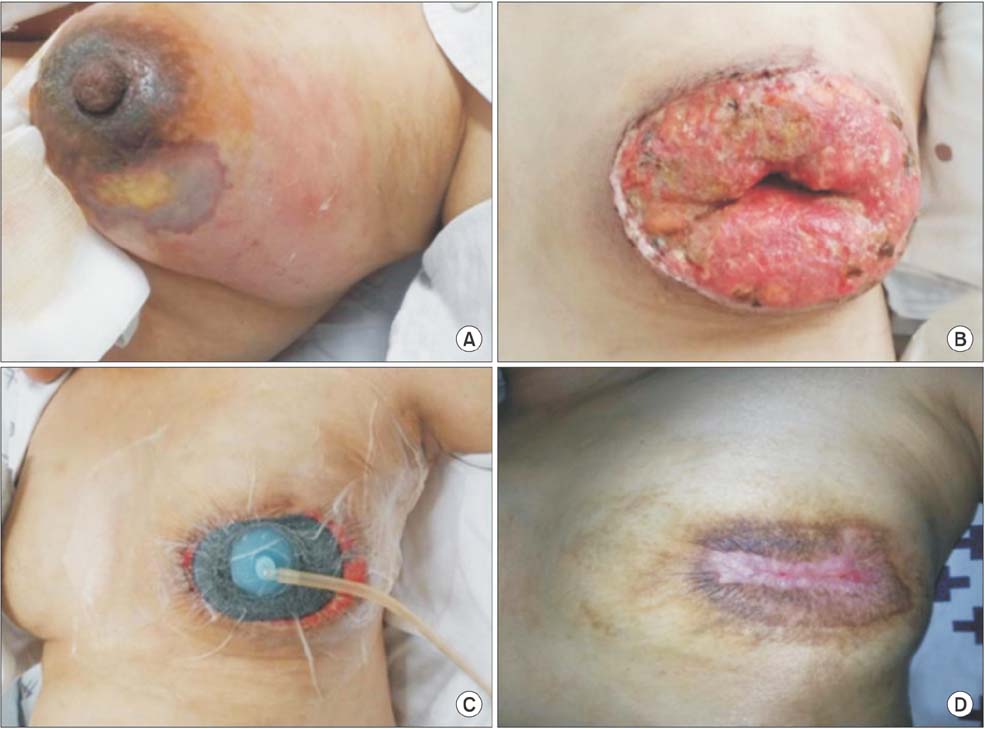Ann Surg Treat Res.
2015 Aug;89(2):102-106. 10.4174/astr.2015.89.2.102.
Necrotizing fasciitis of the breast in a pregnant woman successfully treated using negative-pressure wound therapy
- Affiliations
-
- 1Department of Surgery, Daejeon St. Mary's Hospital, The Catholic University of Korea College of Medicine, Daejeon, Korea. sun2729@naver.com
- KMID: 2166979
- DOI: http://doi.org/10.4174/astr.2015.89.2.102
Abstract
- Necrotizing fasciitis (NF) is a rare and rapidly progressive disease involving the skin, subcutaneous tissue, and deep soft tissue. Although NF can occur any part of the body, the breast is an uncommon primary site for NF, and its occurrence in the breast during pregnancy has never previously been reported. Here, we report the case of a healthy 31-year-old pregnant woman who presented with NF of the left breast that was successfully treated with breast-conserving debridement and secondary wound closure using negative-pressure wound therapy.
MeSH Terms
Figure
Reference
-
1. Sarani B, Strong M, Pascual J, Schwab CW. Necrotizing fasciitis: current concepts and review of the literature. J Am Coll Surg. 2009; 208:279–288.2. Angarita FA, Acuna SA, Torregrosa L, Tawil M, Sanchez EF, Heilbron O, et al. Bilateral necrotizing fasciitis of the breast following quadrantectomy. Breast Cancer. 2014; 21:108–114.3. Salcido RS. Necrotizing fasciitis: reviewing the causes and treatment strategies. Adv Skin Wound Care. 2007; 20:288–293.4. Cho YS, Yang HT, Yim H, Park JM, Kim D, Hur J, et al. Necrotizing fasciitis following a small burn. J Korean Surg Soc. 2010; 79:71–74.5. Flandrin A, Rouleau C, Azar CC, Dubon O, Giacalone PL. First report of a necrotising fasciitis of the breast following a core needle biopsy. Breast J. 2009; 15:199–201.6. Elliott D, Kufera JA, Myers RA. The microbiology of necrotizing soft tissue infections. Am J Surg. 2000; 179:361–366.7. Wong CH, Khin LW, Heng KS, Tan KC, Low CO. The LRINEC (Laboratory Risk Indicator for Necrotizing Fasciitis) score: a tool for distinguishing necrotizing fasciitis from other soft tissue infections. Crit Care Med. 2004; 32:1535–1541.8. Yen ZS, Wang HP, Ma HM, Chen SC, Chen WJ. Ultrasonographic screening of clinically-suspected necrotizing fasciitis. Acad Emerg Med. 2002; 9:1448–1451.9. Hanif MA, Bradley MJ. Sonographic findings of necrotizing fasciitis in the breast. J Clin Ultrasound. 2008; 36:517–519.10. Liao EC, Breuing KH. Breast mound salvage using vacuum-assisted closure device as bridge to reconstruction with inferolateral AlloDerm hammock. Ann Plast Surg. 2007; 59:218–224.
- Full Text Links
- Actions
-
Cited
- CITED
-
- Close
- Share
- Similar articles
-
- A Case of Negative Pressure Treatment on Necrotizing Fasciitis
- Application of a Silicone Sheet in Negative-Pressure Wound Therapy to Treat an Abdominal Wall Defect after Necrotizing Fasciitis
- Effective Treatment Using Negative Pressure Wound Therapy for Necrotizing Fasciitis of Scalp Originating from Odontogenic Infection
- Pseudoaneurysm Leading to Necrotizing Fasciitis at the Femoral Arterial Puncture Site
- Necrotizing Fasciitis following Liver Transplantation



